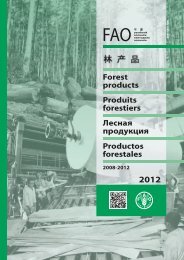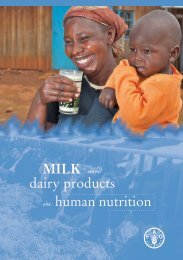You also want an ePaper? Increase the reach of your titles
YUMPU automatically turns print PDFs into web optimized ePapers that Google loves.
XXII<br />
Hardboard<br />
Wet-process fibreboard of a density exceeding 0.8 g/cm 3 . Before<br />
1995, this product was a component of the compressed<br />
fibreboard product category, so data for this product is not<br />
available for 1994 and earlier years. It excludes: similar<br />
products made from pieces of wood, wood flour or other lignocellulosic<br />
material where additional binders are required to make<br />
the panel; and panels made of gypsum or other mineral material.<br />
It is reported in cubic metres solid volume.<br />
Medium Density Fibreboard (MDF)<br />
Dry-process fibreboard. When density exceeds 0.8 g/cm 3 , it<br />
may also be referred to as “high-density fibreboard” (HDF).<br />
Before 1995, this product was a component of the compressed<br />
fibreboard product category, so data for this product is not<br />
available for 1994 and earlier years. It is reported in cubic<br />
metres solid volume.<br />
Insulating Board<br />
Wet-process fibreboard of a density not exceeding 0.8 g/cm 3 .<br />
Before 1995, this product was referred to as non-compressed<br />
fibreboard. It is reported in cubic metres solid volume.<br />
PULP AND RECOVERED PAPER<br />
Wood Pulp<br />
Fibrous material prepared from pulpwood, wood chips,<br />
particles, residues or recovered paper by mechanical and/or<br />
chemical process for further manufacture into paper,<br />
paperboard, fibreboard or other cellulose products. In the<br />
production and trade statistics, it represents the sum of:<br />
mechanical wood pulp; semi-chemical wood pulp; chemical<br />
wood pulp; and dissolving wood pulp. It is reported in metric<br />
tons air-dry weight (i.e. with a 10% moisture content).<br />
Mechanical Wood Pulp<br />
Wood pulp obtained by grinding or milling pulpwood or residues<br />
into fibres, or through refining chips or particles. Also called<br />
ground wood pulp and refiner pulp, it may be bleached or<br />
unbleached. It includes: chemi-mechanical and thermomechanical<br />
pulp. It excludes: exploded and defibrillated pulp. It<br />
is reported in metric tons air-dry weight (i.e. with a 10%<br />
moisture content).<br />
Semi-Chemical Wood Pulp<br />
Wood pulp obtained by subjecting pulpwood, wood chips,<br />
particles or residues to a series of mechanical and chemical<br />
treatments, none of which alone is sufficient to make the fibres<br />
separate readily. It may be bleached or unbleached. It includes:<br />
semi-chemical wood pulp; chemi-ground wood pulp; and chemimechanical<br />
wood pulp etc.(named in the order and importance of<br />
the treatment during the manufacturing process). It is reported<br />
in metric tons air-dry weight (i.e. with a 10% moisture content).<br />
Chemical Wood Pulp<br />
Wood pulp obtained by subjecting pulpwood, wood chips,<br />
particles or residues to a series of chemical treatments. It<br />
includes: sulphate (kraft) wood pulp; soda wood pulp; and<br />
sulphite wood pulp. It may be bleached, semi-bleached or<br />
unbleached. It excludes dissolving grades of wood pulp. It is<br />
reported in metric tons air-dry weight (i.e. with a 10% moisture<br />
content). Where detail is available, statistics for the following four<br />
component pulps are also given: unbleached sulphite pulp;<br />
bleached sulphite pulp; unbleached sulphate pulp; and bleached<br />
sulphate pulp.<br />
Unbleached Sulphite Pulp<br />
Bleached Sulphite Pulp<br />
Wood pulp obtained by mechanically reducing pulpwood, wood<br />
chips, particles or residues to small pieces that are<br />
subsequently cooked in a pressure vessel in the presence of a<br />
bisulphite cooking liquor. Bisulphites such as ammonium,<br />
calcium, magnesium and sodium are commonly used in this<br />
process. It excludes dissolving grades of wood pulp. It is<br />
reported in metric tons air-dry weight (i.e. with a 10% moisture<br />
content) and data for two classes: bleached (including semibleached);<br />
and unbleached, are reported separately.<br />
Unbleached Sulphate Pulp<br />
Bleached Sulphate Pulp<br />
Wood pulp obtained by mechanically reducing pulpwood, wood<br />
chips, particles or residues to small pieces that are<br />
subsequently cooked in a pressure vessel in the presence of<br />
sodium hydroxide cooking liquor (soda pulp) or a mixture of<br />
sodium hydroxide and sodium sulphite cooking liquor (sulphate<br />
pulp). It excludes dissolving grades of wood pulp. It is reported<br />
in metric tons air-dry weight (i.e. with a 10% moisture content)<br />
and data for two classes: bleached (including semi-bleached);<br />
and unbleached, are reported separately.<br />
Dissolving Wood Pulp<br />
Chemical pulp (sulphate, soda or sulphite) made from wood of<br />
special quality, with a very high alpha-cellulose content (usually<br />
90 percent and over). This type of pulp is always bleached and is<br />
readily adaptable for uses other than paper-making. It is used<br />
principally as a source of cellulose in the manufacture of<br />
products such as synthetic fibres, cellulose plastic materials,<br />
lacquers and explosives. It is reported in metric tons air-dry<br />
weight (i.e. with a 10% moisture content).<br />
Other Fibre Pulp<br />
Pulp manufactured from fibrous vegetable materials other than<br />
wood and used for the manufacture of paper, paperboard,<br />
fibreboard and other uses. It includes pulps made from: straw;<br />
bamboo; bagasse; esparto; other reeds or grasses; cotton fibres;<br />
flax; hemp; rags; and other textile wastes. It excludes pulp<br />
made from recovered paper. It is reported in metric tons airdry<br />
weight (i.e. with a 10% moisture content).<br />
Recovered Paper<br />
Waste and scraps of paper or paperboard that have been<br />
collected for re-use or trade. It includes: paper and paperboard<br />
that has been used for its original purpose and residues from<br />
paper and paperboard production. It is reported in metric tons.<br />
PAPER AND PAPERBOARD<br />
Paper and Paperboard<br />
The paper and paperboard category is an aggregate category. In<br />
the production and trade statistics, it represents the sum of:<br />
newsprint; printing and writing paper; and other paper and<br />
paperboard. Products in this category are generally<br />
manufactured in strips or rolls of a width exceeding 15 cm (36 cm<br />
for HS 48.13 and 48.19) or in rectangular sheets with one side<br />
exceeding 36 cm and the other exceeding 15 cm in the unfolded<br />
state. It excludes manufactured paper products such as boxes,<br />
cartons, books and magazines, etc. It is reported in metric<br />
tons.<br />
Newsprint<br />
Uncoated paper, unsized (or only slightly sized), containing at<br />
least 60 percent mechanical wood pulp (percentage of fibrous<br />
content), usually weighing not less than 40 g/m 2 and generally<br />
not more than 60 g/m 2 , of the type used mainly for the printing of<br />
newspapers. It is reported in metric tons.<br />
Paper and Paperboard other than Newsprint<br />
The paper and paperboard category is an aggregate category. It<br />
comprises: other printing and writing paper; and other paper<br />
and paperboard. It only appears in tables showing direction of<br />
trade. It is reported in metric tons.<br />
Printing and Writing Paper<br />
Paper, except newsprint, suitable for printing and business<br />
purposes, writing, sketching, drawing, etc. Made from a variety of<br />
pulp blends and with various finishes. It includes: papers used<br />
for books and magazines; wallpaper base stock; box lining and<br />
covering; calculator paper; rotonews; duplicating tablet or block;<br />
labels; lithograph paper; banknotes; tabulating card stock; bible<br />
or imitation bible paper; stationery; manifold paper; onionskin;<br />
typewriter paper; and poster paper, etc. It is reported in metric<br />
tons.







